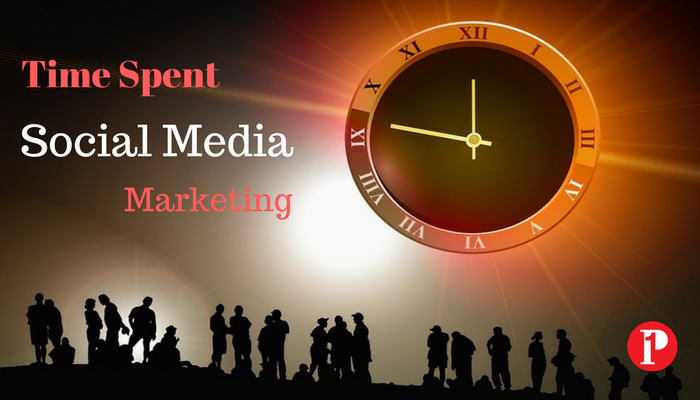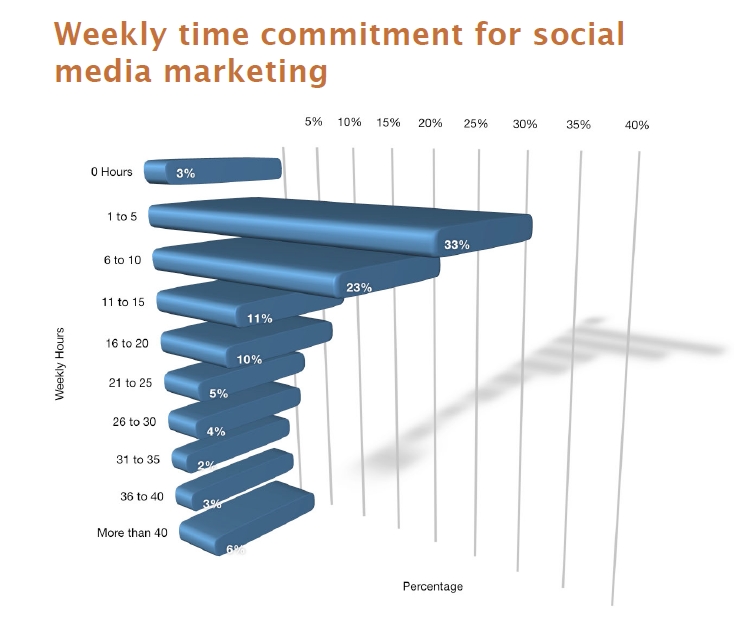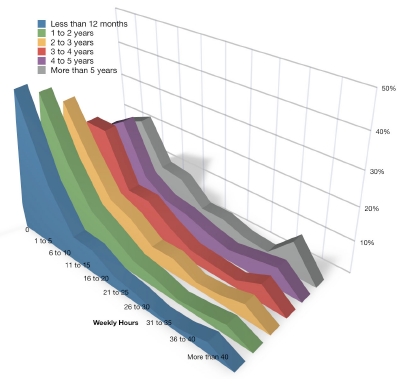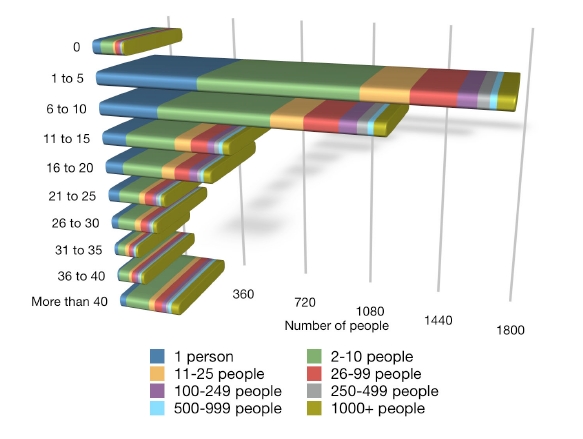
How much time do you devote to social media each week?
How does that compare to other businesses? Your competitors?
The average internet user is now on social media and messaging services for over 2 hours per day. This shows the central role that social is playing in the daily lives of today’s internet users.
As the influence of social media continues to rise, we take a closer look at how this trend has evolved over time.
Social Media can be a total drain on resources if you don’t use it correctly. You can put in hours per day crafting the perfect Tweet, pinning things on Pinterest for your customers, or publicizing your latest viral video on Facebook; but if no one ends up buying anything from you, then it’s all been a waste of time.
So how do you know when enough’s enough?
It’s about what you post
If you just post trash ten times a day, people won’t care what you’re saying, and they’ll switch off. If you take the time to make something good, it’ll be worth it.
THINK QUALITY
But wait, lots of social media posts means lots of eyes on my brand…
Think about your goal – what is it you want to get from social media? It’s not just a case of “More sales, more money.”
- Do you want to use it to build a brand?
- Are you just looking to promote your products/services more directly?
- Are you trying to become the authority in your industry?
- Or simply be more interactive with your customers, as a means of customer service?
Used correctly, time spent on social media offers an excellent return on your investment. You can use it to create an image of your brand; coming across as relatable, empathetic and maybe even cool; rather than corporate and stuffy.
Think who your customers are
WEEKLY TIME COMMITMENT FOR SOCIAL MEDIA MARKETING
This is the first question that you need to ask yourself: How much time should I spend on social media marketing every week?
A study conducted by Social Media Examiner Industry Report 2017 asked 5,700 marketers how much time they allocate to social media marketing, and the entire report is worth reading, but here’s an overview of how much time marketers spend on social media marketing each week.

The truth is, there’s no exact formula for deciding how much time to spend on your own social efforts. Large corporations can have multiple social media managers working around the clock, while smaller shops may only dedicate a few hours to social every week.
It’s all a matter of testing to see what works for you.
But no matter how much time you do decide to spend on social, you need to determine how to allocate your time to make sure that you’re working as efficiently as possible.
THE EXPERIENCE FACTOR
There’s a direct relationship between how long marketers have been using social media and their weekly time commitment.
For people just beginning with social media (less than 12 months of experience), 51% spend 5 or fewer hours per week.
However, of folks who have been doing this for 2 years or longer, at least 65% spend 6 hours or more per week on social media activities.

HOW TIME COMMITMENT VARIES WITH BUSINESS SIZE

A significant 64% of marketers are using social media for 6 hours or more and 41% for 11 hours or more weekly.
It’s interesting to note that nearly 20% of marketers spend more than 20 hours each week on social media.
Obviously the larger the business, the more resources they have to devote to social media marketing. Yet, I know many small businesses that have all there employees posting, with that said, they clearly define the field of play.
What’s in bounds, what’s out of bounds. No one wants to damage their brand with a wayward tweet.
30 MINUTES A DAY?
According to marketing automation software company Pardot, most marketers—or in the case of small businesses, owners or staff members tasked with social media—don’t know “how to tackle the mountain that is social media and wind up wasting a lot of time haphazardly updating and monitoring their social presence.” That’s why the folks at Pardot developed an infographic that outlines how to complete social media in just 30 minutes per day. I recommend checking out the full infographic, but here’s the jist:
- Twitter: Devote ten minutes to responding to any direct tweets or messages; use an automation app to schedule tweets (I like Buffer) promoting any recent blog posts or other content, events, or specials; and scroll through your feed to re-tweet or share any relevant content.
- Facebook: Spend six minutes responding to any comments, scrolling through your feed to engage with others’ comments, and sharing and promoting your own content.
- LinkedIn: Take six minutes to share content and engage with your LinkedIn groups and your company page.
- Pinterest: Devote four minutes to pinning any new content of your own, repinning others’ content that’s relevant to your brand, and engaging with those who’ve liked, commented on, or pinned your content—a quick “thanks” is all it takes.
- Google+: Spend two minutes sharing content and posing questions in your status update.
- Instagram: Take two minutes to post an interesting photo of your staff, facility, or presence within the community; also, scroll through your feed and like and comment on any images that are relevant.
Don’t have a profile on one of the above-mentioned social media sites? That’s totally fine. Devote that extra time to your other profiles.
Chris Brogan’s Social Media Time Management
This post is from 2009, but the advice is timeless. Chris Brogan, the CEO of Owner Media Group, recommends breaking your social media efforts into four chunks; then determine the total amount of time you can devote and go from there. While Brogan believes that two hours per day is the minimum for most efforts, that isn’t a hard-fast rule—although Americans spend an average of 3.2 hours per day on social, according to Ipsos, so maybe a couple hours isn’t too far-fetched. Here’s how Brogan divides up the social media time pie:
- ¼ time = listening: “Start your day by listening and finding what the world is saying about you, your competitor, your marketplace, etc.”
- ½ time = commenting and communication: Spend time commenting and replying back to people on the various channels where they reach you…I also include sharing [here].”
- ¼ time = creating: “Your efforts in content creation are every bit as important as your connectivity and communication. This might include blogging, making video or audio, creating email newsletters…”
How to Save Time
According to Buffer, “Smaller companies, including many entrepreneurs and startups, spend a disproportionately larger amount of time on social media [than larger businesses] due to smaller staffs and lower budgets.” The team at Buffer also found that people waste a lot of time on social media—6 hours, 48 minutes to be exact. (Here is Buffer’s full pie-chart breakdown.)
I’m a big fan of Buffer, but also use Hootsuite which is my favorite.
Common sense says to cut out these time-sucks so you’re far more efficient and effective at social media, but how do you do that? Here’s what Buffer recommends:
- Automate your social media posting. Pardot recommended this in its 30-minute-a-day social media plan. And what do you know? Buffer is a social media scheduling and auto-posting tool.
- Budget a half hour—max—every day to scour the web for relevant content to share. (The article breaks it down further with specific time duration’s to devote to each social media platform.)
- Assign a customer service team member to address questions and inquires.
- Stop trying to gauge ROI by measuring “how many people liked or retweeted a post.” Instead, measure the right kind of metrics.
Source: Social Media Examiner
FINAL THOUGHTS
It’s clear the trend, businesses and individuals are spending more time on social media. That creates more noise, and sometimes can get us off track.
Be clear about your goals and objectives. Tie them to the social media platforms that work best for either your B2B or B2C business.
Guard your time wisely. It’s easy to get carried away with the latest trending article on Facebook, and lose track of your time and your goals and objectives.
Be clear about your social media strategies and the time it will take to accomplish your goals and objectives.
Think quality over quantity.
Remember these social media platforms are rented land! We live in changing times, and social media platforms are no exception.
Remember When MySpace was King?
Social Media sites will come and go. Point being…do not neglect your website. You have total control and last I checked most people like control.
Social Media Should NOT be Your Primary Web Presence
In fact, it should be used to support your website, not replace it. With so many different social media channels available, it makes sense to seek out which ones can support your website.
For example, you might use YouTube to host your product videos while embedding them on your website. Or use Twitter to promote your latest blog posts, while using Facebook to share how your business is active in the local community, and you could use create a B2B LinkedIn strategy to generate leads.
About Blair

Blair Evan Ball is a Social Media Coach and founder of Prepare1, a company that works with businesses, individuals and non-profits. He is a former executive with a Fortune 50 company, and his national division did $1Billion+ in sales annually.
Blair has written three e-books: Facebook for Business Made Easy, Facebook Pages for Business Made Easy, and WordPress Blog Setup Made Easy.
Blair also educates, trains entrepreneurs and business professionals how to amplify their brand, increase revenues, and raise more funds.
![[Study] How Will Businesses Change Their Social Media Activities 5 Golden Rules for Sharing on Social Media](https://www.prepare1.com/wp-content/uploads/2014/03/COACH-logohat-162x300.jpg) The Race is ON! | PREPARE | Get into the Game and WIN!
The Race is ON! | PREPARE | Get into the Game and WIN!










Comments on this entry are closed.